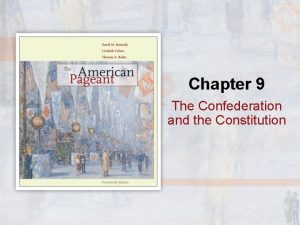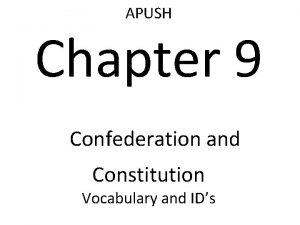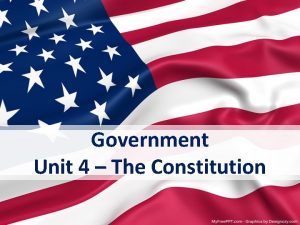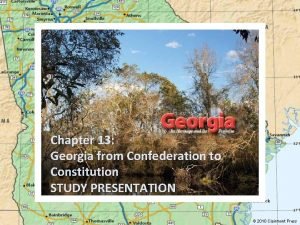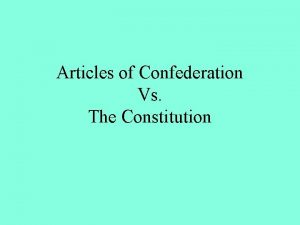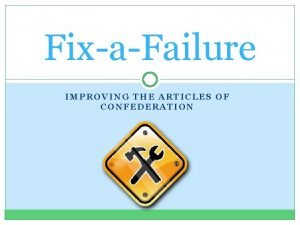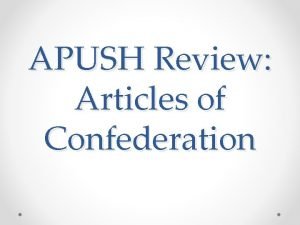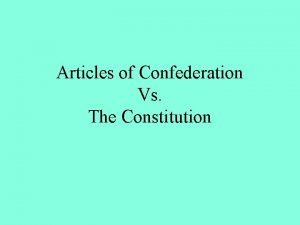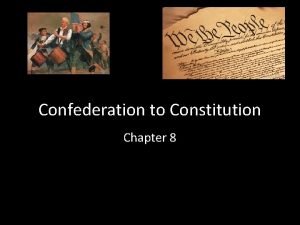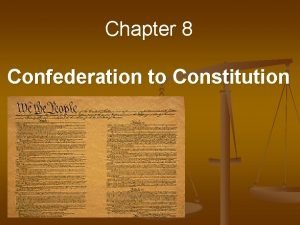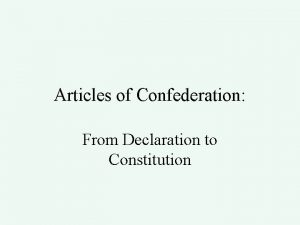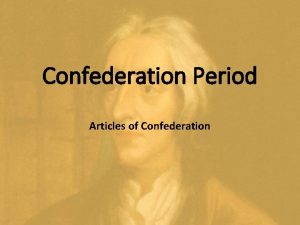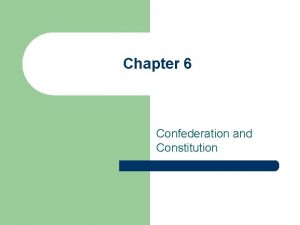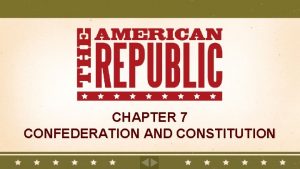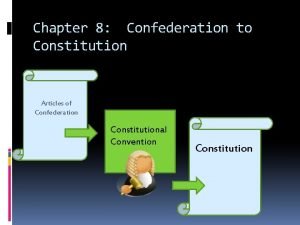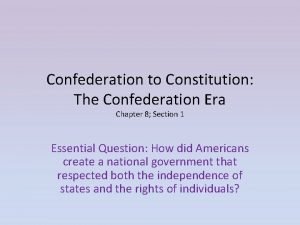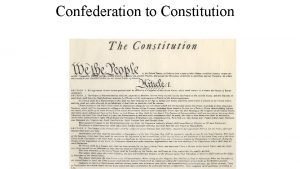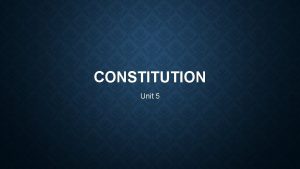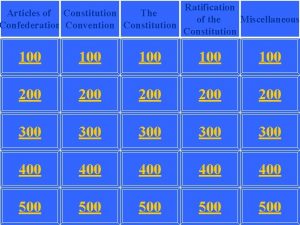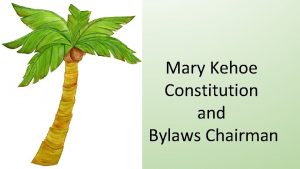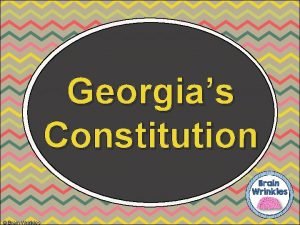Confederation and the Constitution Confederation In the Declaration
















- Slides: 16

Confederation and the Constitution

Confederation • In the Declaration of Independence, Americans looked to form a REPUBLIC: a government in which citizens rule through elected representatives. • Second Continental Congress in 1781 set up Articles of Confederation, an alliance among the 13 states to work together.

Problems with the Articles of Confederation ü Each state got 1 vote regardless of population ü Any changes in articles must be approved by all states ü No executive branch or legal branch to enforce laws. ü Each state still acting as individuals, not as a unified country.

National Debt caused troubles • America had huge debt from revolution. States raised taxes, hurting farmers. • Daniel Shay led farmers to force courts to stop them from taking away land to pay debts. Quickly put down, killing 4 farmers. • Shay’s Rebellion made people see need for a stronger national government.

Compromise • How do you have fair representation of both large and small states? • James Madison wanted 2 separate houses, both based on population. Smaller states opposed it • The Compromise was for 2 houses, one based on population (House of Representative) and one on having equal representation of each state (Senate)

The 3/5 Compromise • Southern States wanted Slaves to count in population for house of representatives • Northerners, who had few slaves, argued against it. • Compromise said 3/5 of Shame on you, slave population would be America! counted, or slaves = 3/5 a regular person

Separation of Powers • To limit authority of national government, they created 3 branches of government. • LEGISLATIVE: Congress. Job is to Make laws • EXECUTIVE: President. Job is to carry out laws. • JUDICIAL: Supreme Court. Job is to hear cases

Checks & Balances • They established this three branch system so that one group couldn’t dominate the other two.

Electoral College • When electing a president, Delegates feared putting too much power in hands of the people. • Each state would choose electors based on number of senators & congressmen • This Electoral College would then elect the president. We Know! • Still used today

Ratifying the Constitution

Federalists vs. Anti-federalists FEDERALISTS • Wanted a balance of power between states and central government • The Federalist Papers told why there should be a central gov. • Madison, Hamilton, & Jay ANTI-FEDERALISTS • Opposed strong, central government, so they opposed the constitution • Letters from a Federal Farmer told why no central gov. • Protect freedom of press, religion, other rights

Bill of Rights • All individual states guaranteed rights of individual citizens • Anti-federalists wanted a written guarantee in the constitution – Feared big government • Federalists said not necessary, but relented • Bill of rights spells out individuals rights in the constitution

Know your rights! First Amendment guarantees citizens to freedom of • religion, • speech, • the press • political activity

Know your rights! • 2 nd Amendment gives citizens the right to bear arms as members of the militia • 3 rd Amendment says government can not put troops in your house during times of peace

Know your rights! • 4 th Amendment says government cannot search you or your home without a warrant

Good stuff to Know • • • Articles of Confederation Shay’s Rebellion 3/5 compromise Electoral College Federalist Papers Letters from a Federal Farmer • What were some problems with the Articles of Confederation? • What are three branches of government? What are their jobs? • Federalists vs. Antifederalists: what are the differences.
 Chapter 9 the confederation and the constitution
Chapter 9 the confederation and the constitution Chapter 9 confederation and constitution
Chapter 9 confederation and constitution Articles of confederation vs constitution
Articles of confederation vs constitution Articles of confederation vs constitution
Articles of confederation vs constitution Constitution vs articles of confederation
Constitution vs articles of confederation Issues with the articles of confederation
Issues with the articles of confederation Articles of confederation apush
Articles of confederation apush Articles of confederation vs constitution chart
Articles of confederation vs constitution chart Chapter 8 confederation to constitution
Chapter 8 confederation to constitution Chapter 8 confederation to constitution
Chapter 8 confederation to constitution Texas constitution vs u.s. constitution venn diagram
Texas constitution vs u.s. constitution venn diagram Nc constitution vs us constitution
Nc constitution vs us constitution Constitution what is constitution
Constitution what is constitution The constitution lesson 1 principles of the constitution
The constitution lesson 1 principles of the constitution Offering declaration
Offering declaration Ey2 declaration and consent form
Ey2 declaration and consent form Weaknesses and strengths of the articles of confederation
Weaknesses and strengths of the articles of confederation
